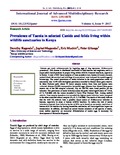Prevalence of Taenia in selected Canids and felids living within wildlife sanctuaries in Kenya

View/
Date
2017Author
Kagendo, Dorothy
Magambo, Japhet
Muchiri, Eric
Gitonga, Peter
Metadata
Show full item recordAbstract
Humans get cystic echinococcosis by ingesting eggs of dog tapeworm,Echinococcus granulosus. This disease is distributed worldwide in both humans and ungulates, and is a major public health problem in people living within wildlife livestock interfaces, especially in Kenya. A total of 832 faecal samples of lions (panthera leo),hyenas (Crocuta crocuta),jackals (Canis Mesomelas) and wild dogs (Lycaon pictus) were screened for taeniid eggs by microscopy. The overall prevalence of taenia infection in the study population across all sanctuaries was 14.4% with the highest prevalence recorded in Maasai Mara game reserve.In Meru National park, where 74 faecal samples mainly from lions and hyenas were collected, thirteen (10.8%) were positive for taeniid eggs, whereas from Maasai Mara game
reserve out of the 284 samples collected, fifty six (46.7%) were found positive for the infection. The prevalence oftaenia infection across the parks varied significantly (X2=24.8,d.f 5, P<0.000) with the lowest recorded in Tsavo West National Park Among studied animals, lions samples(panthera leo) recorded the highest taenia infection levels comparedto the other examined animal samples (X2=21.5, P<0.000).The results of this study indicate that the wild life animals form a possible major source of Echinococcus infection to humans, especially in areas of human wildlife interface. To reduce the risk of taenia infection to humans from infection by the wildlife cycle, based on our results, restriction of human wild life interface by fencing around the sanctuaries will have significant impact on transmission. In addition, and based on several known existence of sub species of taenia,more studies especially on molecular differentiation of taenia eggs is necessary for development of Molecular diagnosis.
